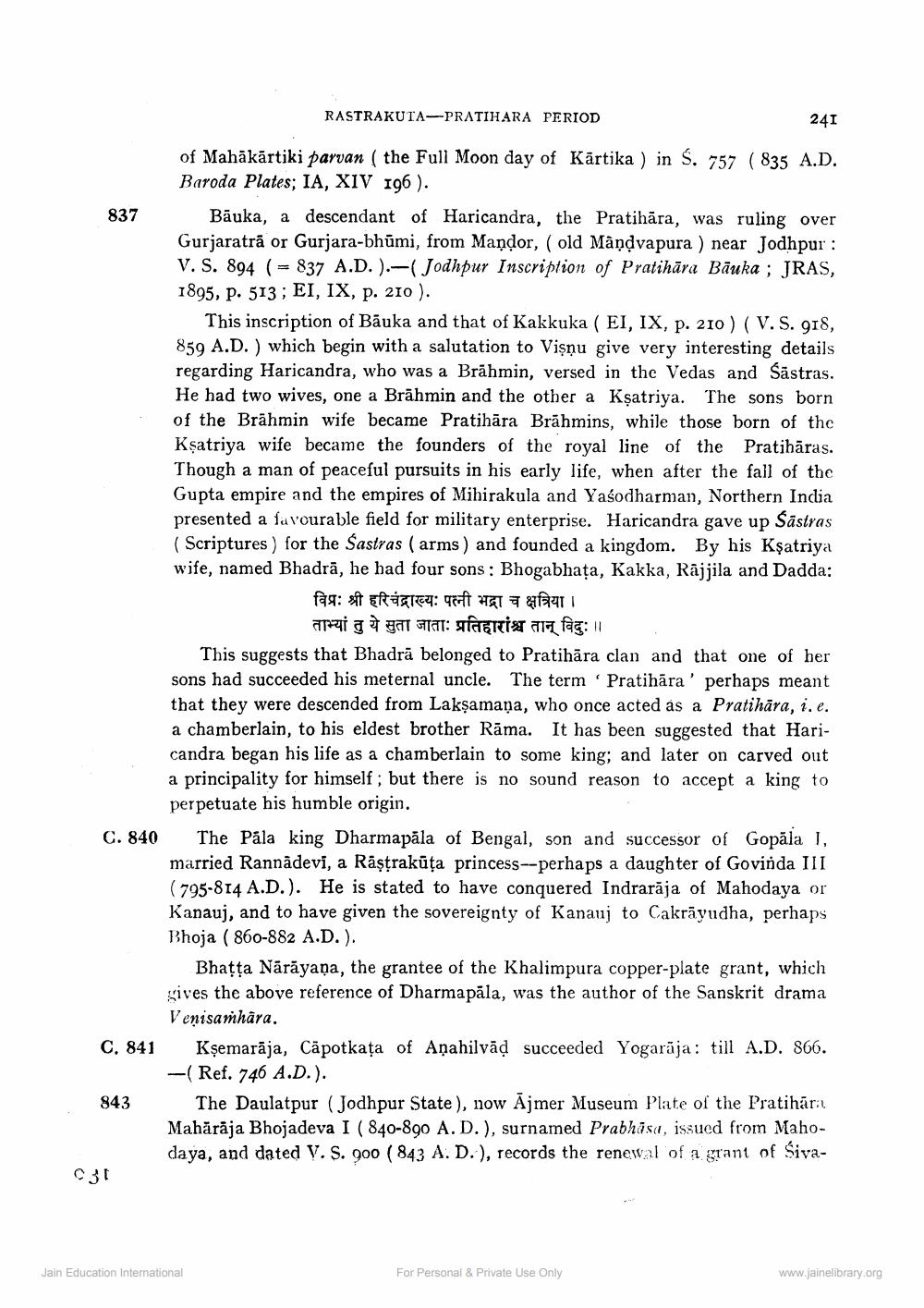________________
RASTRAKUTA-PRATIHARA PERIOD
241
of Mahākārtiki parvan ( the Full Moon day of Kärtika) in $. 757 ( 835 A.D.
Baroda Plates; IA, XIV 196). 837 Bāuka, a descendant of Haricandra, the Pratihāra, was ruling over
Gurjaratrā or Gurjara-bhūmi, from Maņdor, (old Mänavapura ) near Jodhpur : V. S. 894 (= 837 A.D.):-( Jodhpur Inscription of Pratihāra Bāuka ; JRAS, 1895, p. 513; EI, IX, p. 210 ).
This inscription of Bāuka and that of Kakkuka ( EI, IX, p. 210 ) ( V. S. 918, 859 A.D.) which begin with a salutation to Vişņu give very interesting details regarding Haricandra, who was a Brāhmin, versed in the Vedas and Sāstras. He had two wives, one a Brāhmin and the other a Kșatriya. The sons born of the Brāhmin wife became Pratihāra Brāhmins, while those born of the Ksatriya wife became the founders of the royal line of the Pratihāras. Though a man of peaceful pursuits in his early life, when after the fall of the Gupta empire and the empires of Mihirakula and Yaśodharman, Northern India presented a favourable field for military enterprise. Haricandra gave up Šāstras ( Scriptures) for the Sastras ( arms) and founded a kingdom. By his Kșatriya wife, named Bhadrā, he had four sons: Bhogabhata, Kakka, Rājjila and Dadda:
विप्रः श्री हरिचंद्राख्यः पत्नी भद्रा च क्षत्रिया।
ताभ्यां तु ये सुता जाताः प्रतिहारांश्च तान् विदुः ।। This suggests that Bhadrā belonged to Pratihāra clan and that one of her sons had succeeded his meternal uncle. The term 'Pratihāra' perhaps meant that they were descended from Lakşamaņa, who once acted as a Pratihāra, i.e. a chamberlain, to his eldest brother Rāma. It has been suggested that Haricandra began his life as a chamberlain to some king; and later on carved out a principality for himself; but there is no sound reason to accept a king to
perpetuate his humble origin. C. 840 The Pála king Dharmapāla of Bengal, son and successor of Gopāla I,
married Rannādevi, a Rāştrakūta princess--perhaps a daughter of Govinda III (795-814 A.D.). He is stated to have conquered Indrarāja of Mahodaya or Kanauj, and to have given the sovereignty of Kanauj to Cakrāyudha, perhaps Bhoja ( 860-882 A.D.).
Bhatta Nārāyaṇa, the grantee of the Khalimpura copper-plate grant, which gives the above reference of Dharmapala, was the author of the Sanskrit drama
Venisamhära. C. 841 Ksemarāja, Cäpotkața of Anahilvād succeeded Yogarāja: till A.D. 866.
- Ref. 746 A.D.). 843 The Daulatpur (Jodhpur State), now Ājmer Museum Plate of the Pratihär:
Mahārāja Bhojadeva I ( 840-890 A.D.), surnamed Prabhasa, issued from Mahodaya, and dated V. S. 900 ( 843 A. D.), records the renewal of a grant of Siva
C30
Jain Education International
For Personal & Private Use Only
www.jainelibrary.org




